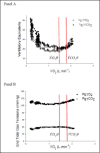A Systematic Method to Detect the Metabolic Threshold from Gas Exchange during Incremental Exercise
- PMID: 28912658
- PMCID: PMC5592292
A Systematic Method to Detect the Metabolic Threshold from Gas Exchange during Incremental Exercise
Abstract
Incremental exercise consists of three domains of exercise intensity demarcated by two thresholds. The first of these thresholds, derived from gas exchange measurements, is defined as the metabolic threshold (V̇O2θ) above which lactate accumulates. Correctly and reliably identified, V̇O2θ is a non-invasive, sub-maximal marker of aerobic function with practical value. This investigation compared variability in selection of V̇O2θ among interpreters with different levels of experience as well as from auto-detection algorithms employed by a commercially available metabolic cart (MC). Ten healthy young men performed three replicates of incremental cycle exercise during which gas exchange measurements were collected breath-by-breath. Two experienced interpreters (E) and four novice interpreters (N) determined V̇O2θ from plots of specific response variables. Interpreters noted methods used and confidence in their selections. V̇O2θ was automatically determined by the MC. Interclass correlations indicated that E agreed with each other (mean difference, 21 mL·min-1) and with the MC (23 mL·min-1), but not with N (-664 to 364 mL·min-1); N did not agree among themselves. Despite good overall agreement between E and MC, differences >500 mL·min-1 were seen in 50% of individual cases. N expressed unduly higher confidence and used different V̇O2θ selection strategies compared with E. Experience and use of a systematic approach is essential for correctly identifying V̇O2θ. Current guidelines for exercise testing and interpretation do not include recommendations for such an approach. Data from this study suggests that this may be a serious shortcoming. Until an alternative schema for V̇O2θ detection is developed prospectively, strategies based on the present study will give practitioners a systematic and consistent approach to threshold detection.
Keywords: Incremental exercise testing; lactate threshold; metabolic threshold; oxygen uptake.
Figures





Similar articles
-
Heart Rate Acquisition and Threshold-Based Training Increases Oxygen Uptake at Metabolic Threshold in Triathletes: A Pilot Study.Int J Exerc Sci. 2019 Jan 1;12(2):144-154. doi: 10.70252/HNHZ4958. eCollection 2019. Int J Exerc Sci. 2019. PMID: 30761193 Free PMC article.
-
Testosterone Attenuates Age-Related Fall in Aerobic Function in Mobility Limited Older Men With Low Testosterone.J Clin Endocrinol Metab. 2016 Jun;101(6):2562-9. doi: 10.1210/jc.2015-4333. Epub 2016 Apr 6. J Clin Endocrinol Metab. 2016. PMID: 27050869 Free PMC article. Clinical Trial.
-
Eccentric exercise-induced muscle damage dissociates the lactate and gas exchange thresholds.J Sports Sci. 2011 Jan;29(2):181-9. doi: 10.1080/02640414.2010.526626. J Sports Sci. 2011. PMID: 21170804 Clinical Trial.
-
A conceptual framework for performance diagnosis and training prescription from submaximal gas exchange parameters--theory and application.Int J Sports Med. 2005 Feb;26 Suppl 1:S38-48. doi: 10.1055/s-2004-830514. Int J Sports Med. 2005. PMID: 15702455 Review.
-
Determination of aerobic capacity and the severity of chronic cardiac and circulatory failure.Circulation. 1987 Dec;76(6 Pt 2):VI40-5. Circulation. 1987. PMID: 3315299 Review.
Cited by
-
Heart Rate Acquisition and Threshold-Based Training Increases Oxygen Uptake at Metabolic Threshold in Triathletes: A Pilot Study.Int J Exerc Sci. 2019 Jan 1;12(2):144-154. doi: 10.70252/HNHZ4958. eCollection 2019. Int J Exerc Sci. 2019. PMID: 30761193 Free PMC article.
-
Behavioral Modification Enhances the Benefits from Structured Aerobic and Resistance Training.Sports Med Int Open. 2019 Jul 15;3(2):E48-E57. doi: 10.1055/a-0900-7501. eCollection 2019 Apr. Sports Med Int Open. 2019. PMID: 31312715 Free PMC article.
-
The importance of ventilatory thresholds to define aerobic exercise intensity in cardiac patients and healthy subjects.Scand J Med Sci Sports. 2021 Sep;31(9):1796-1808. doi: 10.1111/sms.14007. Epub 2021 Jul 5. Scand J Med Sci Sports. 2021. PMID: 34170582 Free PMC article.
-
Preparation for an Half-Ironmantm Triathlon amongst Amateur Athletes: Finishing Rate and Physiological Adaptation.Int J Exerc Sci. 2020 May 1;13(6):766-777. doi: 10.70252/OWPW6610. eCollection 2020. Int J Exerc Sci. 2020. PMID: 32509136 Free PMC article.
-
From data to decision: Machine learning determination of aerobic and anaerobic thresholds in athletes.PLoS One. 2024 Aug 29;19(8):e0309427. doi: 10.1371/journal.pone.0309427. eCollection 2024. PLoS One. 2024. PMID: 39208146 Free PMC article.
References
-
- Beaver W.L., Wasserman K., Whipp B.J. (1986) A new method for detecting anaerobic threshold by gas exchange. Journal of Applied Physiology 60, 2020-2027. - PubMed
-
- Bechard D., Wetstein L. (1987) Assessment of exercise oxygen consumption as preoperative criterion for lung resection. The Annals of Thoracic Surgery 44, 344-349. - PubMed
-
- Belman M.J., Epstein L.J., Doornbos D., Elashoff J.D., Koerner S.K., Mohsenifar Z. (1992) Noninvasive determinations of the anaerobic threshold. Reliability and validity in patients with COPD. Chest 102, 1028-1034. - PubMed
-
- Bland J.M., Altman D.G. (1986) Statistical methods for assessing agreement between two methods of clinical measurement. The Lancet 1, 307-310. - PubMed
-
- Boulay M.R., Hamel P., Simoneau J.A., Lortie G., Prud'homme D., Bouchard C. (1984) A test of aerobic capacity: description and reliability. Canadian Journal of Applied Sport Sciences 9, 122-126. - PubMed
Grants and funding
LinkOut - more resources
Full Text Sources
Miscellaneous
